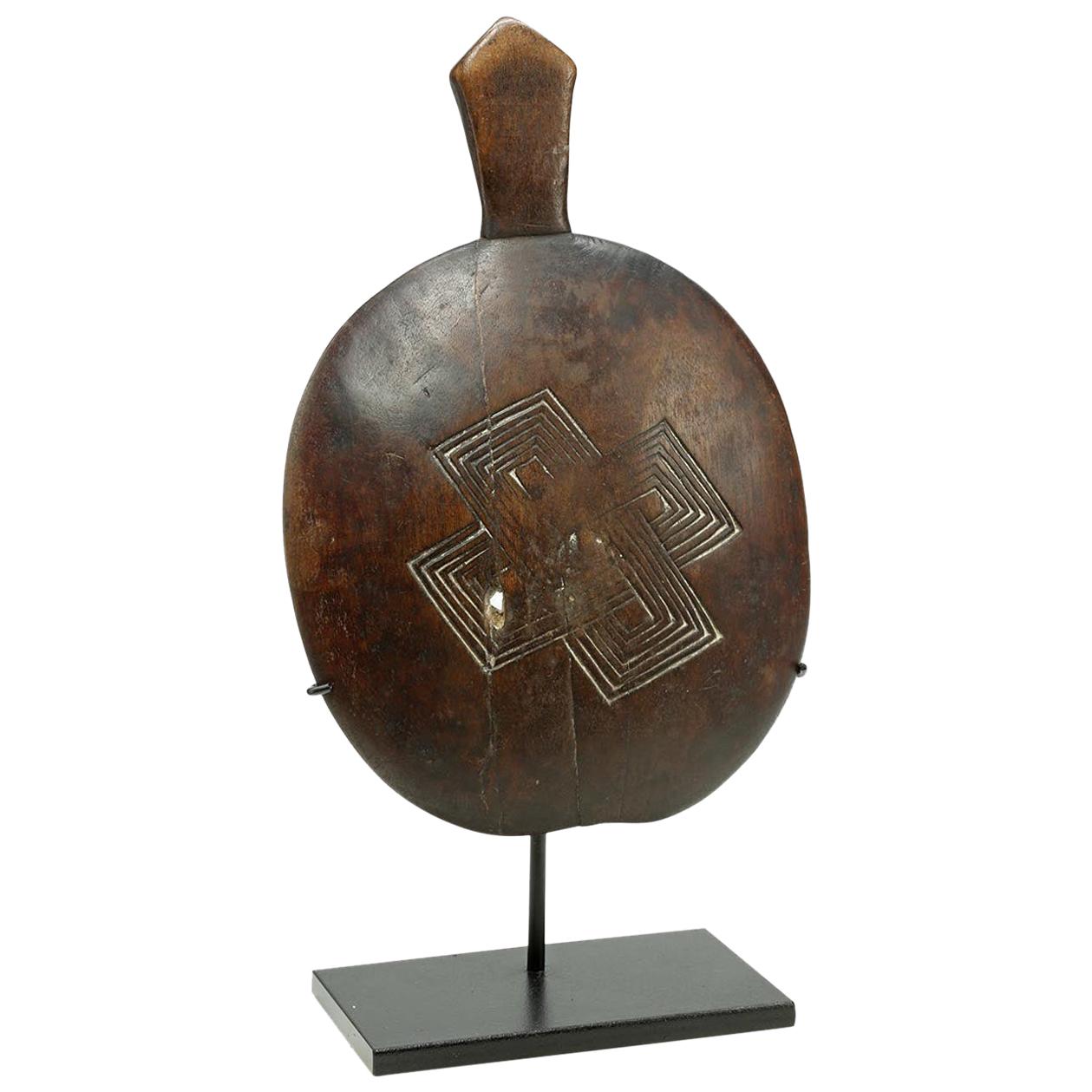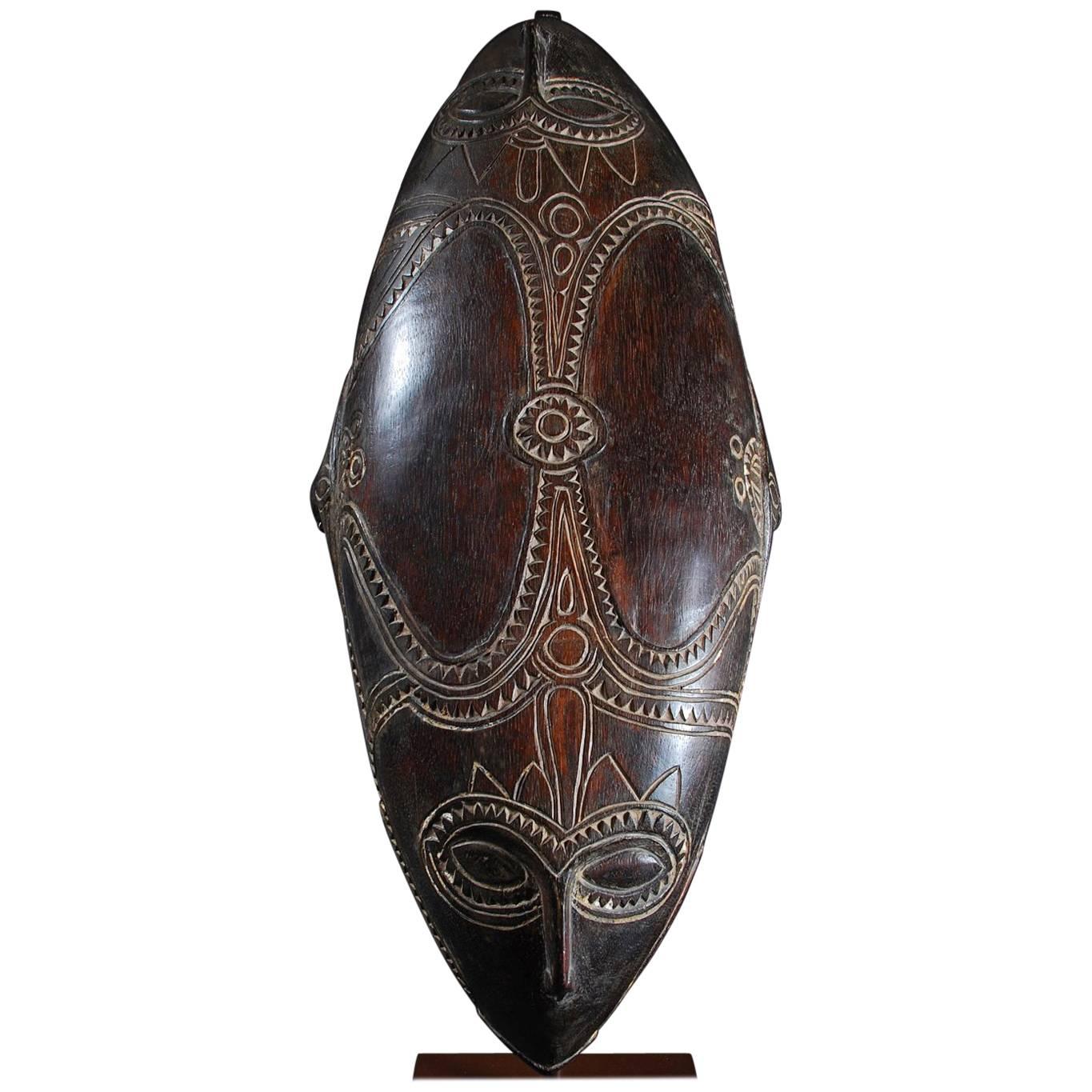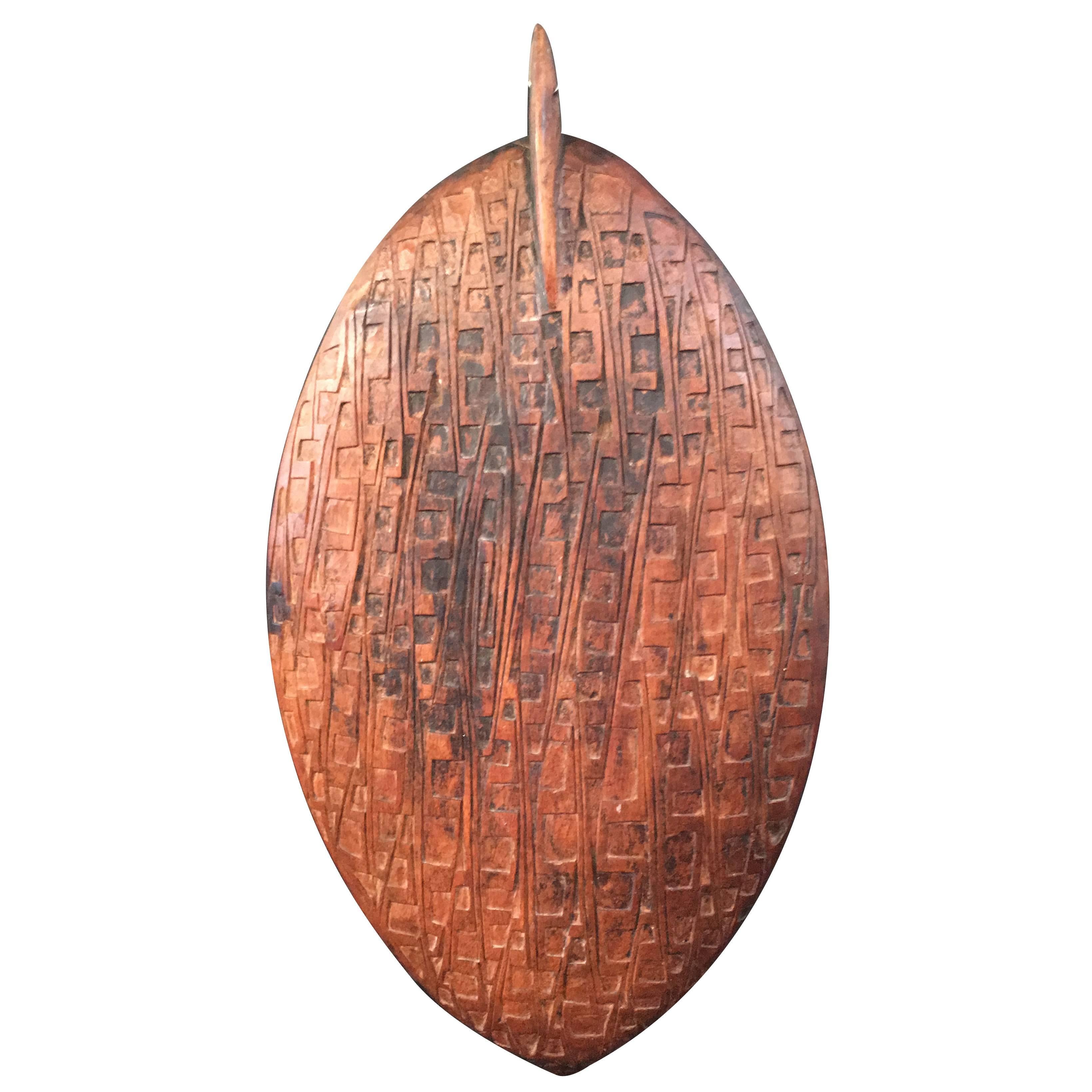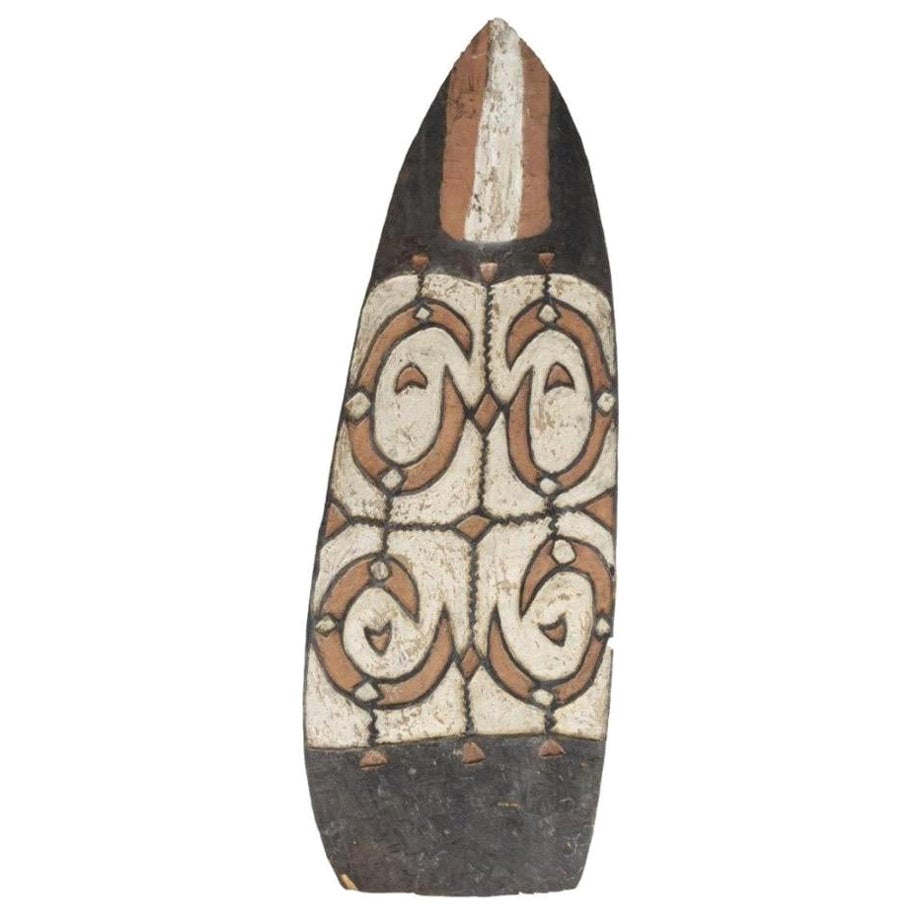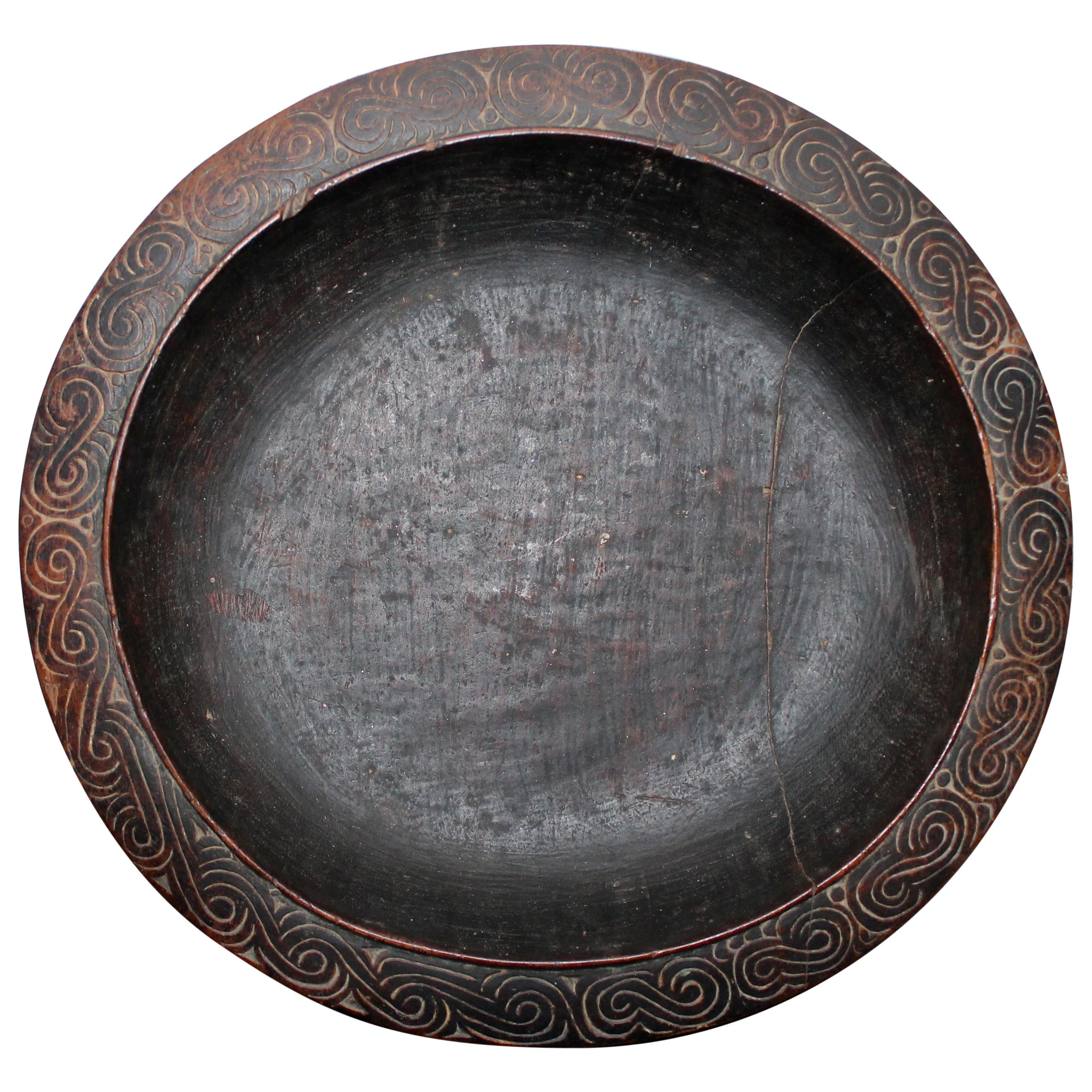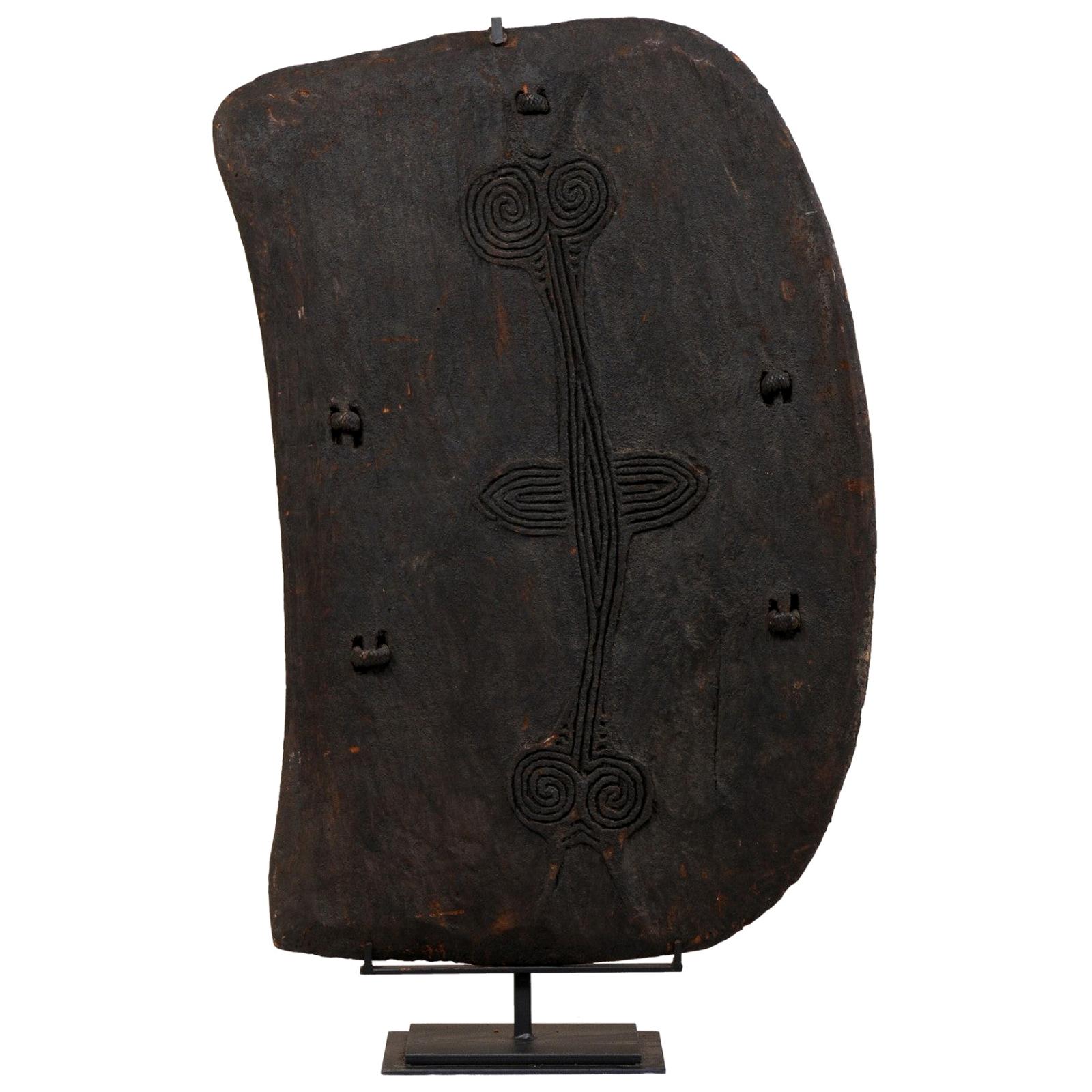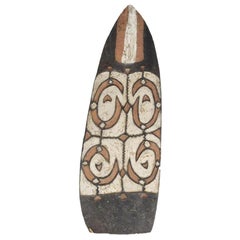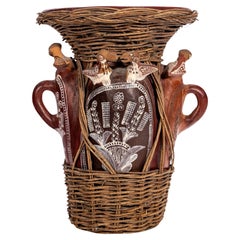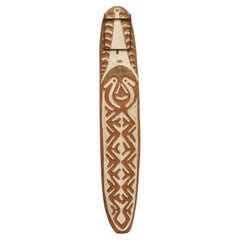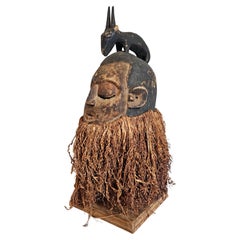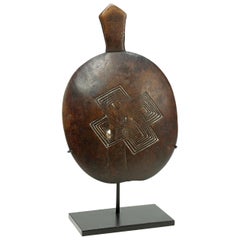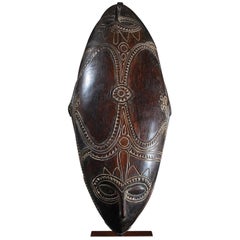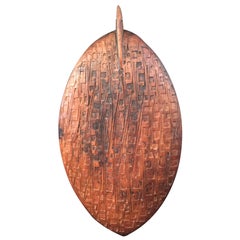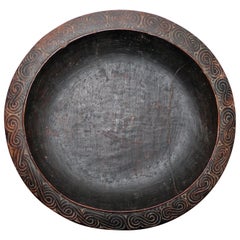Items Similar to Important Oceanic Carved Asmat Tribal Sago Bowl Serving Platter after War Shield
Want more images or videos?
Request additional images or videos from the seller
1 of 11
Important Oceanic Carved Asmat Tribal Sago Bowl Serving Platter after War Shield
$1,250
£949.48
€1,094.12
CA$1,760.31
A$1,951.56
CHF 1,025.62
MX$23,883.94
NOK 12,808.99
SEK 12,022.51
DKK 8,166.92
About the Item
A rare and important Oceanic Papuan Asmat tribal carved ancestral sago bowl (also known as a platter, serving shield and tray) crafted in the likes of the owners war shield.
Collected from the coast of the headhunter tribe in Papua New Guinea, a Provincial Indonesian island, in the mid 20th century, this impressive wooden sculpture was hand-carved and polychrome painted using only primitive tools and pigments for color. Surmounted by a male figure (owners ancestor) with intricately carved eyes, nose, and mouth, shown with one arm bent, one extended attached to lower tray, painted in red pigment obtained from ochre, white pigment from crushed limestone lighting the wood and black from black soot or a burnt piece of wood.
Having various carved symbols and shapes detailing the personal name of the bowl owner, their ancestors, as well as symbolic references to them, often giving the ancestor and in effect owner power, strength, agility etc.
They were used during festivals and ceremonies, where the larvae of the Capricorn beetle or sago worms are held in these containers, before being consumed, in effect, the clansman believed even more of the Ancestors powers would be transferred to them.
The bowl is in excellent shape with good patina. Interesting, unusual and highly decorative, it makes for a wonderful conversation piece. There is a wire across the back for wall hanging, the corresponding metal stand is also included.
Dimensions approx 32.5" High, 14.5" Wide, 2" Deep, 8 lbs.
---
Brief history:
Located in southwestern New Guinea, a Province of Indonesia in Oceania, the Asmat live along the coast where a vast system of rivers flow into the Arafura Sea. With an estimated population of 70,000, the Asmat are divided into several hundred villages ranging in size from 35 to 2,000 inhabitants.
From Dirk Smidt, Asmat Art, New York: Braziller, 1993. Smidt says: 'In a culture where death was never accidental and all required avenging in a continuous cycle of warfare, shields served a practical purpose of protection but also the symbols carved on the shields radiated power, invigorating the shields owner and striking fear into the enemy. The shields are named after dead relatives. The magical powers of the shield gave the carrier exceptional power combining his strength with that of the deceased ancestor to which the shield shared the name. The shields were used not just in battle but to scare off evil spirits that may have brought misfortune to the village. These shields were made for a shield feast which initiated a headhunting expedition.
Headhunting raids were an important element of Asmat culture until missionaries suppressed the practice, which, according to some accounts, persisted into the 1990s. The death of an adult, even by disease, was believed to be caused by an enemy, and relatives sought to take a head in an endless cycle of revenge and propitiation of ancestors. Heads were thought necessary for the rituals in which boys were initiated into manhood. Cannibalism was a subsidiary feature of the rituals that followed the taking of heads
Among the Asmat, war shields are the most powerful symbolic element of a warrior's equipment, and have many layers of meaning. Traditionally, they were functional items used to protect warriors in battle by deflecting an enemy's spears and arrows. The carved and painted images on the surface of the shields were also intended to frighten the enemy and symbolize the power of the ancestors.
Wood carving is a flourishing tradition among the Asmat, and wood carvers are held in high esteem. The culture hero Fumeripits is considered to be the very first wood carver, and all subsequent wood carvers (known as wowipits) have an obligation to continue his work. The Asmat also believe that there is a close relationship between humans and trees, and recognize wood as the source of life.
Ancestral imagery appears on multiple forms of Asmat art, including wood war shields. Shields were created as functional items for warfare, and were meant to protect the user from the spears and arrows of his enemy. At the same time, the imagery that is carved and painted on the surface of the shield endows the piece with the power of the ancestors, which is also intended to protect the user. The designs can be either figural or abstract, depending on the region from which the shield came.
Excellent condition
Museum quality, original, vintage condition. Wear consistent with age and use. Please note, one hand has been professionally restored.
All of our items are guaranteed to be authentic and as described in perpetuity.
- Dimensions:Height: 32.5 in (82.55 cm)Width: 14.5 in (36.83 cm)Depth: 2 in (5.08 cm)
- Style:Tribal (Of the Period)
- Materials and Techniques:
- Place of Origin:
- Period:
- Date of Manufacture:First half of the 20th century
- Condition:Repaired: Please note, one hand has been professionally restored. Wear consistent with age and use. Minor losses. Minor fading. Museum quality, original, vintage condition. Please note, one hand has been professionally restored. Guaranteed authentic in perpetuity.
- Seller Location:Forney, TX
- Reference Number:1stDibs: LU5977240248822
About the Seller
4.8
Platinum Seller
Premium sellers with a 4.7+ rating and 24-hour response times
Established in 2013
1stDibs seller since 2021
296 sales on 1stDibs
Typical response time: <1 hour
- ShippingRetrieving quote...Shipping from: Forney, TX
- Return Policy
Authenticity Guarantee
In the unlikely event there’s an issue with an item’s authenticity, contact us within 1 year for a full refund. DetailsMoney-Back Guarantee
If your item is not as described, is damaged in transit, or does not arrive, contact us within 7 days for a full refund. Details24-Hour Cancellation
You have a 24-hour grace period in which to reconsider your purchase, with no questions asked.Vetted Professional Sellers
Our world-class sellers must adhere to strict standards for service and quality, maintaining the integrity of our listings.Price-Match Guarantee
If you find that a seller listed the same item for a lower price elsewhere, we’ll match it.Trusted Global Delivery
Our best-in-class carrier network provides specialized shipping options worldwide, including custom delivery.More From This Seller
View AllMonumental Oceanic Asmat People Carved Painted Wooden War Shield
Located in Forney, TX
A monumental, rare and important Oceanic Papuan Asmat People tribal carved war shield from the first half of the 20th century, collected from the coast of the headhunting tribe in Papua New Guinea, a Provincial Indonesian island in the mid 20th century.
Among the Asmat, war shields are the most powerful symbolic element of a warrior's equipment, and have many layers of meaning. Traditionally, they were functional items used to protect warriors in battle by deflecting an enemy's spears and arrows. The carved and painted images on the surface of the shields were also intended to frighten the enemy and symbolize the power of the ancestors.
Ancestral imagery appears on multiple forms of Asmat art...
Category
Early 20th Century Papua New Guinean Tribal Tribal Art
Materials
Wood
Peru Folk Art Pottery Clay Wicker Zoomorphic Bird Quinua Harvest Vase Sculpture
Located in Forney, TX
A rare and exceptional vintage Peruvian folk art pottery harvest vase.
Hand-crafted in Peru, most likely Ayacucho region / Quinua, the South American primitive executed in distinct...
Category
20th Century Peruvian Folk Art Sculptures and Carvings
Materials
Clay, Pottery, Terracotta, Wicker
Large Oceanic Gope Carved Wooden Ancestor Spirit Board
Located in Forney, TX
An Oceanic "Gope" Papuan ancestral spirit board, 20th century, collected from the Gulf Province, Papua, New Guinea, Kerewa or Hohao village tribe.
Hand...
Category
20th Century Papua New Guinean Folk Art Sculptures and Carvings
Materials
Metal
Antique Congolese African Tribal Carved Hemba Helmet Mask, Suku Peoples
Located in Forney, TX
A scarce antique African tribal carved Hemba helmet mask, the Suku peoples, possibly Kwese culture, Democratic Republic of the Congo, Central Africa, early 20th century, surmounted by four-legged animal, over round face, with mouth ajar and incised jagged teeth exposed, protruding almond shaped eyes, scattered remnants of pigment, full raffia fiber fringe, mounted on wood stand.
A superb museum quality example, this remarkable tribal folk art sculpture is a wonderful way to add rustic warmth, rich historical depth, and fascinating cultural interest to any space!
Dimensions: (approx)
Overall: 26" High, 9" Wide, 10.25" Deep;
Mask only: 15" Tall;
7 lbs total
Provenance / Acquisition:
Acquired from the highly reputable auction house, Austin Auction Gallery, est.1983, Austin, Texas.
Excellent Condition:
Nicely aged distressed patina over the whole. Highly desirable wear consistent with age and indicative of use, including scattered losses, antique character marks and typical signs of aging throughout. Retaining scattered remnants of original pigment. Overall a superb museum quality example
Primitive Arts Of Africa:
Among the Suku of the southwestern part of the Democratic Republic of the Congo, masks plays crucial role in protecting boys during initiation, the vulnerable period between boyhood and manhood. The power contained in Hemba masks...
Category
Early 20th Century Congolese Tribal Tribal Art
Materials
Raffia, Wood
Antique Native American Indigenous Peoples Carved Polychrome Canoe Model
Located in Forney, TX
An exceptionally rare antique Native American / Indigenous Peoples hand carved and painted wooden dugout canoe model, dating to the early 20th century or earlier, likely Pacific Nort...
Category
Early 20th Century North American Native American Sculptures and Carvings
Materials
Twine, Wood, Paint
18th Century Swedish Carved Mangle Board
Located in Forney, TX
A long hand carved wooden mangle board (clothing and bedding press) with beautiful patina.
Handmade in Sweden, circa 1744, this Scandinavian antique with...
Category
Antique 18th Century Swedish Primitive Sculptures and Carvings
Materials
Wood
You May Also Like
Old Worn Kuba Tribal Platter Incised Design, Early 20th Century, Congo
Located in Point Richmond, CA
Sweet worn, polished and smoothed Kuba ceremonial serving platter with handle and incised Classic royal Kuba knot pattern on one side.
Cra...
Category
Early 20th Century Congolese Tribal Tribal Art
Materials
Wood
$665 Sale Price
30% Off
Mid-20th Century Tami Islands Papua New Guinea Tribal Wooden Feast Bowl
Located in Point Richmond, CA
mid-20th century Tami Islands Papua new guinea wooden feast bowl
Of classic form, each end carved with raised and incised imagery depicting stylized sea cr...
Category
Mid-20th Century Papua New Guinean Tribal Art
Materials
Kaolin, Wood
Lake Sentani Carved Feasting Platter
Located in Austin, TX
A well carved festival feasting platter. One end featuring a long billed water bird head. The exterior carved with a traditional complex interlocking motif. The interior plain and di...
Category
Early 20th Century Indonesian Tribal Tribal Art
Materials
Hardwood
Massim Food Bowl Trobriand Islands Papua New Guinea
Located in Sharon, CT
Ornately decorated rim, with abstract carvings on bottom. Beautiful rich patina.
Category
Early 20th Century Oceanic Tribal Tribal Art
Materials
Wood
Papua New Guinea Carved-Wood Lumi Shield on Custom Iron Stand
Located in Atlanta, GA
A Papua New Guinea carved-wood Lumi shield from the mid-20th century. This vintage war shield from the West Sepik region, the northwestern most province of...
Category
Mid-20th Century Papua New Guinean Sculptures and Carvings
Materials
Iron
Early Large Food Bowl, Tami Islands, Huon Gulf, Papua New Guinea
Located in Point Richmond, CA
Early Large Food Bowl, Tami Islands, Huon Gulf, Papua New Guinea
This large food bowl exhibits a pleasing asymmetry in the raised relief carving of the t...
Category
Early 20th Century Papua New Guinean Tribal Abstract Sculptures
Materials
Wood
More Ways To Browse
Carved Shield
Wood Shield
Tribal Wall Hanging
Carved Wood Shield
Tree Of Life Folk Art
Worm Wood
Wall Hanging Vintage Folk Art
Southwestern Wall Art
Painted Metal Bowl
Vintage Painted Metal Tray
Burnt Wood Sculpture
Wooden Platter
Tree Of Life Wall Hanging
Vintage Black Wood Bowl
Beetles Sculpture
Mid Century Black Metal Serving Tray
Carved Ancestor Figure
Well And Tree Platter
